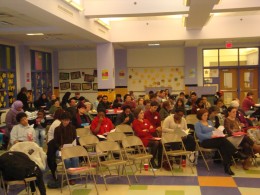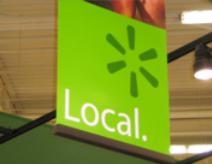Aug
10
11:37 am
by Stacy Mitchell
Local Signage....at Wal-Mart
HSBC, one of the biggest banks on the planet, has taken to calling itself “the world’s local bank.” Starbucks is un-branding at least three of its Seattle outlets, the first of which just reopened as “15th Avenue Coffee and Tea.” Winn-Dixie, a 500-outlet supermarket chain, recently launched a new ad campaign under the tagline, “Local flavor since 1956.” The International Council of Shopping Centers, a global consortium of mall owners and developers, is pouring millions of dollars into television ads urging people to “Shop Local” - at their nearest mall. Even Wal-Mart is getting in on the act, hanging bright green banners over its produce aisles that simply say, “Local.”
Hoping to capitalize on growing public enthusiasm for all things local, some of the world’s biggest corporations are brashly laying claim to the word “local.”
This new variation on corporate greenwashing - local washing - is, like the buy-local movement itself, most advanced in the context of food. Hellmann’s, the mayonnaise brand owned by the processed-food giant Unilever, is test-driving a new “Eat Real, Eat Local,” initiative in Canada. The ad campaign seems aimed partly at enhancing the brand by simply associating Hellmann’s with local food. But it also makes the a claim that Hellmann’s is local, because most of its ingredients come from North America.
It’s not the only industrial food company muscling in on local. Frito-Lay’s new television commercials use farmers as pitchmen to position the company’s potato chips as local food, while Foster Farms, one of the largest producers of poultry products in the country, is labeling packages of chicken and turkey “locally grown.”
Corporate local-washing is now spreading well beyond food. Barnes & Noble, the world’s top seller of books, has launched a video blog site under the banner, “All bookselling is local.” The site, which features “local book news” and recommendations from employees of stores in such evocative-sounding locales as Surprise, Arizona, and Wauwatosa, Wisconsin, seems designed to disguise what Barnes & Noble is - a highly centralized corporation where decisions about what books to stock and feature are made by a handful of buyers - and to present the chain instead a collection of independent-minded booksellers.
Across the country, scores of shopping malls, chambers of commerce, and economic development agencies are also appropriating the phrase “buy local” to urge consumers to patronize nearby malls and big-box stores. In March, leaders of a new Buy Local campaign in Fresno, California, assembled in front of the Fashion Fair Mall for a kick-off press conference. Flanked by storefronts bearing brand names like Anthropologie and The Cheesecake Factory, officials from the Economic Development Corporation of Fresno County explained that choosing to “buy local” helps the region’s economy. For anyone confused by this display, the campaign and its media partners, including Comcast and the McClatchy-owned Fresno Bee, followed the press conference with more than $250,000 worth of radio, TV, and print ads that spelled it out: “Just so you know, buying local means any store in your community: mom-and-pop stores, national chains, big-box stores - you name it.”
The Real Buy Local Movement
In one way, all of this corporate local-washing is good news for local economy advocates: It represents the best empirical evidence yet that the grassroots movement for locally produced goods and independently owned businesses now sweeping the country is having a measurable impact on the choices people make.
“Think of the millions of dollars these big companies spend on research and focus groups. They wouldn’t be doing this on a hunch,” observed Dan Cullen of the American Booksellers Association (ABA), a trade group which represents some 1,700 independent bookstores and last year launched IndieBound, an initiative that helps locally owned businesses communicate their independence and community roots.
Signs that consumer preferences are trending local abound. Locally grown food has soared in popularity. The U.S. is now home to 4,385 active farmers markets, one out of every three of which was started since 2000. Food co-ops and neighborhood greengrocers are on the rise. Driving is down, while data from several metropolitan regions show that houses located within walking distance of small neighborhood stores have held value better than those isolated in the suburbs where the nearest gallon of milk is a five-mile drive to Target.
A growing number of independent businesses are trumpeting their local ownership and community roots, and reporting a surge in customer traffic as a result. In April, even as Virgin Megastores prepared to shutter is last U.S. record store, independent music stores across the country were mobbed for the second annual Record Store Day. A celebration of local music retailers that features in-store concerts and exclusive releases, the event drew hundreds of thousands of music fans into stores, was one of the top search terms on Google, and triggered a 16-point upswing in album sales, according to Neilson SoundScan.
In city after city, independent businesses are organizing and creating the beginnings of what could become a powerful counterweight to the big business lobbies that have long dominated public policy. Local business alliances - like Stay Local in New Orleans, the Metro Independent Business Alliance in Minneapolis-St Paul, and Arizona Local First in Phoenix - have now formed in over 130 cities and collectively count some 30,000 businesses as members. Through grassroots “buy local” and “local first” campaigns, these alliances are calling on people to choose independent businesses and local products more often and making the case that doing so is critical to rebuilding middle-class prosperity, averting environmental collapse, and ensuring that our daily lives are not smothered by corporate uniformity.
Surveys and anecdotal reports from business owners suggest that these initiatives are in fact changing spending patterns. A survey of 1,100 independent retailers conducted in January by the Institute for Local Self-Reliance (where I work) found that, amid the worst economic downturn since the Depression, buy-local sentiment is giving local businesses an edge over their chain competitors. While the Commerce Department reported that overall retail sales plunged almost 10 percent over the holidays, the survey found that independent retailers in cities with buy-local campaigns saw sales drop an average of just 3 percent from the previous year. Many respondents attributed this relative good fortune to the fact that more people are deliberately seeking out locally owned businesses.
Corporations Take Note
None of this has slipped the notice of corporate executives and the consumer research firms that advise them. Several of these firms have begun to track the localization trend. In its annual consumer survey, the New York-based branding firm BBMG found that the number of people reporting that it was “very important” to them whether a product was grown or produced locally jumped from 26 to 32 percent in the last year alone. “It’s not just a small cadre of consumers anymore,” said founding partner Mitch Baranowski.
“Food is one of the biggest gateways, but we’re seeing this idea of ‘local’ spread across other categories and sectors,” said Michelle Barry, senior vice president of the Hartman Group. A report published by Hartman last year noted, “There is a belief that you can only be local if you are a small and authentic brand. This isn’t necessarily true; big brands can use the notion of local to their advantage as well.” Barry explains: “Big companies have to be much more creative in how they articulate local … It’s a different way of thinking about local that is not quite as literal.”
One way corporations can be “local” too is to stock a token amount of locally grown produce, as Wal-Mart has done in some of its supercenters. The chain’s local food offerings are usually limited to a few of the main commodity crops of that particular state - peaches in Georgia or potatoes in Maine - and sit amid a sea of industrial food and other goods shipped from the far side of the planet. Yet, this modest gesture has won Wal-Mart glowing coverage in numerous daily newspapers, few of which have asked the salient question: does Wal-Mart, which now captures more than one of every five dollars Americans spend on groceries, create more and better opportunities for local farmers than the grocers it replaces?
Wal-Mart, like other chains, has learned that, with consumers increasingly motivated to support companies they perceive to be acting responsibility, tossing around the word “local” is a far less expensive way to convey civic virtue than the alternatives. “Local is one of the lower-hanging fruits in terms of sustainability,” explains Barry. “It’s easier for companies to do than to improve how their employees are treated or adopt a specific sustainability practice around their carbon footprint, for example.”
Rather than making direct claims using the word “local,” some companies are pushing marketing messages that work by association. One example that caught Dan Cullen’s eye was a CVS television commercial that begins in a Main Street bookshop, following the owner around as she tends to her customers. The bookshop then transforms into a CVS. The bookshop owner is now the customer. The feel is still very much Main Street. “Suddenly the kind of unique, enjoyable, grassroots bookstore experience morphs into a CVS experience,” said Cullen. “There’s a Potemkin façade that a lot of chains are trying to put up because consumers now want something other than a cookie-cutter experience.”
Redefining Local
Still another corporate strategy is to redefine the term “local” to mean, not locally owned or locally produced, but just nearby. “With the term ‘local’ being so nebulous, it seems ripe for manipulation,” notes Mintel, another consumer research firm that counsels companies on how to “craft marketing messages that appeal to locally conscious consumers” and how to avoid “charges of ‘local washing.’” The key, Mintel says, is for companies to decide what they mean by local and to disclose that clearly so as not to be accused of trying to misappropriate the term.
Corporate-oriented buy-local campaigns that define “local” as the nearest Lowe’s or Gap store are now being rolled out in cities nationwide. Some represent desperate bids by shopping malls to survive the recession and fend off online competition. Others are the work of chambers of commerce trying to remain relevant. Still others are the half-baked plans of municipal officials casting about for some way to stop the steep drop in sales tax revenue.
Many of these AstroTurf campaigns are modeled directly on grassroots initiatives. “They copy our language and tactics,” said Michelle Long, executive director of Sustainable Connections, a seven-year-old coalition of 600 independent businesses in northwest Washington state that runs a very visible, and according to market research, very successful “local first” program. “I get calls from chambers and other groups who say, We want to do what you are doing. It took me a while to realize that what they had in mind was not what we do. Once I realized, I started asking them, what do you mean by ‘local’?”
Examples abound. In northern California, the Arcata Chamber of Commerce is producing “Shop Local” ads that look similar to the Humboldt County Independent Business Alliance’s “Go Local” ads, except they feature both independents and chains. Spokane’s Buy Local program, started by the local chamber, is open to any business in town, including big-box stores. Log-on to the Buy Local web site created by the chamber in Chapel Hill, NC, and you will find Wal-Mart among the listings.
When billboards proclaiming “Buy Local Orlando” first appeared in Orlando, Florida, Julie Norris, a café owner who last year co-founded Ourlando, an initiative to support indie businesses, was excited to see the concept getting such visibility. But she soon realized that the city-funded program, which provides businesses who join with a “Buy Local” decal, seminars at the Disney Entrepreneur Center, and a listing on the web site, was open to any business in Orlando. “We sat down with the city and said, What you guys are doing is a real disservice to the local business movement,” she said. When Norris complained publicly, city officials accused Ourlando of being “exclusive” by not allowing chains.
The city did agree to remove from its press materials and web site a reference to a study that found that, for every $100 spent locally, $45 stays in the community. The problem was that the study, conducted by the firm Civic Economics, found that to be true only if the money was spent at a locally owned business. Shop at a chain store, the analysis found, and only $13 of that $100 spent stays in the community.
The Economic Development Corporation (EDC) of Fresno County also appropriated the $45-stays-local statistic when it kicked off its Buy Local campaign at the Fashion Fair Mall. The figure was repeated on a TV news story without any clarification that it did not apply to the types of chains visible in the background. Like the Orlando initiative, the Fresno campaign aims to boost sales tax revenue by deterring online and out-of-town shopping. It goes out of its way in every radio and TV spot to make sure people know that “local” means national chains and big-box stores. “Buy Local” stickers and posters are now visible on malls and chains throughout the Central Valley. “For someone to say you are not local if you are a big box, I say baloney. They invested here,” explained Steve Geil, CEO of the EDC.
“I would prefer that the county’s resources were not being spent promoting Wal-Mart and Home Depot,” said Scott Miller, owner of Gazebo Gardens, a plant nursery founded in 1922. “We have a great history of being involved in community events and donating to local causes. Our plants are grown locally. We believe that our kind of business is more valuable to a community than any big chain.”
When the city of Santa Fe decided to launch a campaign to encourage people to shop locally, the Santa Fe Alliance, a coalition of more than 500 locally owned businesses that has been running a buy-local initiative for several years, signed on. At the kick-off in March, the Alliance’s director, Vicki Pozzebon, emphasized the economic impact of shopping at a locally owned business versus a chain. “After that, the city asked me not to push the $45 vs. $13, but just say ‘local.’” said Pozzebon. The city’s message, according to Kate Noble, a city staffer who runs the program, is that shopping at Wal-Mart is fine, as long as it’s not walmart.com. Pozzebon said, “It has only diluted our message and confused people.”
These sales tax driven campaigns may well be doing more harm to local economies than good, according to Jeff Milchen, co-founder of the American Independent Business Alliance, a national organization that helps communities start and grow local business alliances (and on whose board I serve). “If you encourage people to shop at a big-box store that takes sales away from an independent business, you’re just funneling more dollars out of town, because, unlike chains, local businesses buy lots of goods and services, like accounting and printing, from other local businesses.”
The irony of trying to solve declining city revenue by trying to get people to shop at the local mall is that the mall itself may be the problem. While many California cities are facing budget cuts and even bankruptcy, Berkeley has managed to post a small increase in revenue. Part of the reason, according to city officials, is that Berkeley has more or less said no to shopping malls and big chain stores and is instead a city of locally owned businesses that primarily serve local residents. That creates a much more stable revenue base. Berkeley hasn’t benefited from the temporary boom that a new regional mall might create, but neither has it gone bust.
Will Big Local Triumph?
Can corporations succeed in co-opting “local” - or at least so muddling the term that it no longer has meaning? The Hartman Group’s Barry thinks that’s possible. “For many consumers, these things are not being called into question much. They say, Hey, it’s my local Wal-Mart or my local Frito-Lay truck. It depends where you are on the continuum and how you define local, which is a term that is really up for grabs.”
Milchen is less concerned about what he calls faux-local campaigns in cities where there is already a strong local business organization. “It’s more of an educational opportunity than a problem, so long as they respond to it,” he said. But in places where local enterprises are not organized, he fears these corporate campaigns may succeed in permanently defining “local” for their own benefit. Michelle Long shares that concern: “That’s my fear. People are going to do diluted versions and hold the space so that real campaigns don’t get started.”
Local-washing has prompted local business advocates to reconsider their language. Many are now using the word “independent” more than “local.” Controlling language is critical, said Ronnie Cummins, director of the Organic Consumers Association, who is pushing for tighter regulation of the word organic, as well as rules governing terms like natural, sustainable, and local. “We’ve been fighting so long without the help of federal regulators that some people have forgotten that tool.”
But perhaps local-washing will ultimately make corporations even more suspect and further the case for shifting our economy more in the direction of small-scale, local, and independent. “I think the fact that the chains are trying to play the local card, in a way makes it easier for us,” said the ABA’s Cullen. “I think people are going to recognize that these aren’t authentic and that’s going to make the real thing all the more powerful.”
…
Stacy Mitchell is a senior researcher with the New Rules Project (www.newrules.org) and author of Big-Box Swindle: The True Cost of Mega-Retailers and the Fight for America’s Independent Businesses (Beacon, 2006). If you liked this article, you might also like her monthly newsletter, the Hometown Advantage Bulletin (http://www.newrules.org/hta-signup).







